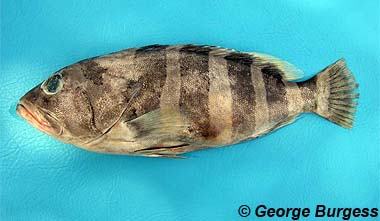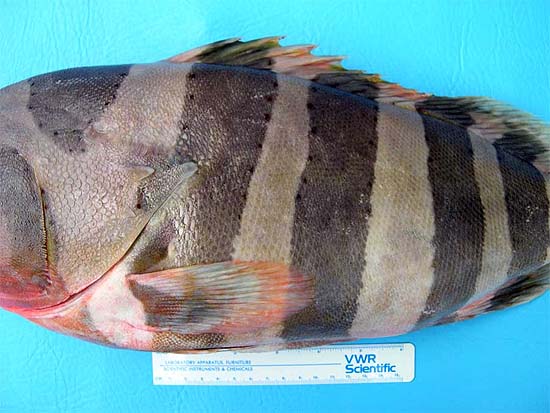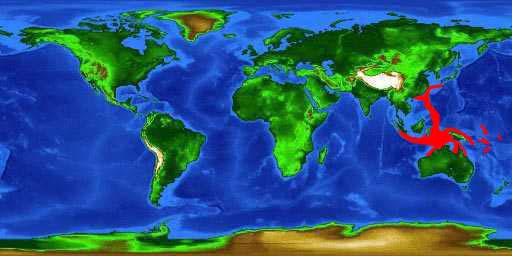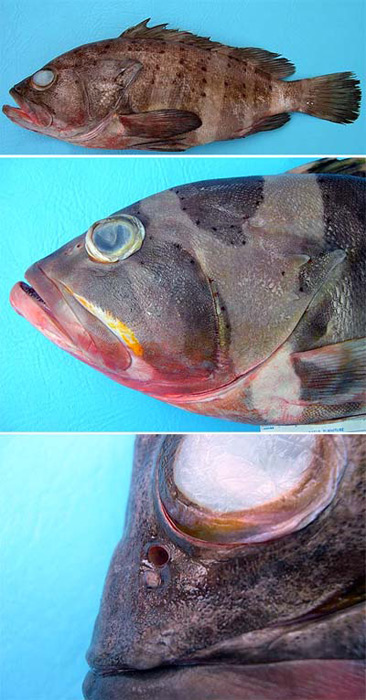
Epinephelus amblycephalus
These tropical reef fish prefer the deeper rocky reefs of the Western Pacific Ocean. They are classical almond-shaped groupers, with pointed snouts and large, round eyes, a continuous spiny dorsal fin, and a rounded caudal (tail) fin. Usually light brown to pale grey, they have a series of wide darker brown bands that extended int their fins, and small dark spots along the edges of some bands. They grow to almost 20 inches in some cases, but little is known about the life cycle and habits of this grouper.
Order: Perciformes
Family: Serranidae
Genus: Epinephelus
Species: amblycephalus
Common Names
Common English language names are banded grouper, bighead grouper, blunt-headed rock cod, white-spotted green grouper, and yellow-lipped rock-cod. Other common names include anak keretang (Malay), anak pertang (Malay), båndet havaborre (Danish), cabrilla venda (Spanish), cá mú ch?m v?ch (Vietnamese), kerapu (Malay), kokuten-aohata (Japanese), lapu-lapu (Kapampangan/Surigaonon/Tagalog), lokos (Hebrew), mérou bande (French), and tabuldlo (Surigaonon).
Importance to Humans

The banded grouper is commercially important in Hong Kong, however in Singapore this species in not a popular grouper in the markets. It is caught with hand lines and typically sold fresh. The banded grouper is used in intensive cage culture in coastal waters in recent years however there appears to be a shortage and unreliable supply of fingerlings in the wild. Current research is aimed at the production of large fingerlings for either culture or restocking local populations.
Conservation
Overfishing is the greatest threat to the banded grouper’s survival. This grouper has been categorized as “Data Deficient” by the World Conservation Union (IUCN) due to the lack of data on current capture numbers along with questions about its distribution. As more information is made available, a re-assessment will be warranted. The IUCN is a global union of states, governmental agencies, and non-governmental organizations in a partnership that assesses the conservation status of species.
> Check the status of the banded grouper at the IUCN website.
Geographical Distribution

The banded grouper resides in the western Pacific region from the Andaman Sea to southern Japan, Taiwan, China, Philippines, Viet Nam, Malaysia, Thailand, Indonesia, New Guinea, the Arafura Sea, northwestern Australia, and Fiji.
Habitat
These tropical grouper is reef-associated at depths from 265-425 feet (80-130 m).
Biology
The body of the banded grouper is stout and robust with a large head. The nostrils are subequal or the posterior nostril is larger than the anterior. The maxilla reaches almost vertical at the rear edge of the eye. The pectoral fin length is equal to the length of the pelvic fin. The caudal fin is rounded.

Coloration
The head and body are pale gray to brown in color with the body having four broad dark brown vertical bands the first two of which extend into the spinous portion of the dorsal fin. The third and fourth bands extend onto the soft dorsal and anal fins. There is a fifth dark bar located at the base of the caudal fin. Small dark spots are present dorsally on the edges of the dark brown bands. There is a dark brown saddle marking on the nape with small black spots along the margins. The cheeks, snout, interorbital area, jaws and chest are primarily dark brown with two or three white bands radiating from each eye. There is an irregular black bar on the middle of the caudal fin. The ventral portions of the head and body often appear having a pinkish tinge. In contrast, juvenile banded groupers are white with black vertical bands on the body while the fins are pale yellow with small black spots.
Dentition
The banded grouper has canines in the front portion of the jaws. There are two rows of teeth at the midside of the lower jaw; teeth are present on the palatines.
Size, Age, and Growth
The maximum reported length of the banded grouper is 19.7 inches (50 cm) total length.
Food Habits
Little is known about the biology and ecology of this grouper species.
Reproduction
Little is known regarding the reproductive habits of this grouper species. However, in captivity newly hatched larvae measure approximately 2.0 mm and possess a large yolk sac.
Predators
Larger fishes and marine mammals are potential predators of the banded grouper.
Taxonomy
The banded grouper was originally described as Serranus amblycephalus by Bleeker in 1857. This name was later changed to the currently valid scientific name of Epinephelus amblycephalus (Bleeker 1857). The genus nameEpinephelus comes from the Greek “epinephelos” translated as cloudy. The family Serranidae includes approximately 450 species and includes the seabasses and groupers.
Prepared by: Cathy Bester